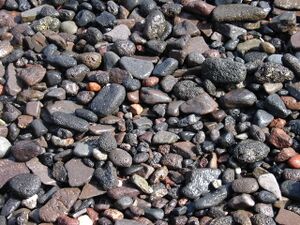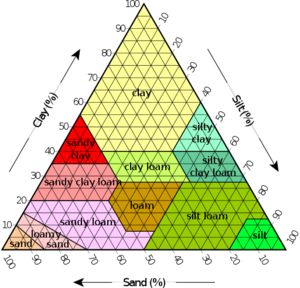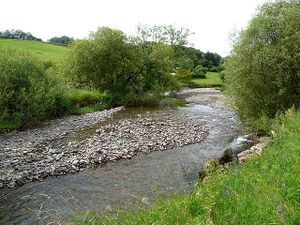Gravel

Overview
Gravel is a loose aggregation of rock fragments which is formed as a result of sedimentary and erosive geologic processes. It is commonly produced in large quantities for commercial purposes.
Gravel can be classified by its grain size range with the Udden-Wentworth scale which categorizes particles by size. Using this scale, gravel can be categorized into two classes; granular gravel (2–4 mm or 0.079–0.157 in) and pebble gravel (4–64 mm or 0.2–2.5 in). Gravel can be further categorized as fine, medium, and course due to these broad ranges of size.
Formation

A geological definition of gravel is “a natural material that consists of water-transported materials and usually has a rounded shape as a result of the water transport.”
It is usually formed with bedrock and quartz but can also contain any other metamorphic, igneous or sedimentary rock.
Types

- Bank Gravel
- naturally deposited gravel which has been mixed with silt, clay, and sand from nearby rivers or streams.
- Bench Gravel
- a bed of gravel located on the surface level of a valley next to a stream representing where the stream use to flow in the past.
- Fine Gravel
- Gravel with a grain size between 2-6.3mm.
- Lag Gravel
- When aeolian processes or fluvial processes remove the finer portion of a sedimentary deposit leaving a layer of the coarser gravel behind.
- Pay Gravel
- Gravel that has a high amount of gold or other precious material in it which can be recovered through screening or panning.
- Piedmont Gravel
- Course gravel which has been transported from a stream/river on a mountain ending up in a relatively flat surface-plain
- Plateau Gravel
- Gravel located on a Plateau which is above the height where stream-created gravel is usually found
- Crushed Stone
- A human-derived form of gravel; stones are crushed with machinery and sent into multiple layers of screens to separate each grain by size to be later sold for commercial use.
Commercial Use
Natural gravel deposits are insufficient for human purposes. Gravel is often produced by quarrying and crushing hard-wearing rocks, such as sandstone, limestone, or basalt. Quarries where gravel is extracted are known as gravel pits. Southern England possesses particularly large concentrations of them due to the widespread deposition of gravel in the region during the Ice Ages.
It begins with using a rock crusher in a location that already has plenty of large rocks, such as a quarry. There are many types of crushers, but their main job is the same: crush larger rocks into smaller pieces to be used for construction material. Crushed stone is then passed through different screeners to be organized and stored in different piles according to their size. The screening process starts by removing larger stones, then medium stones, and eventually goes all the way down to the stone dust.
After being sorted into different piles depending on the size of the stone, the stone is ready to be shipped from the quarry. Quarries deliver directly to job sites, to concrete plants, or to wholesale distributors who sell the stone through retail to customers.
Common Commercial Rocks used in Gravel
- Basalt
- An igneous rock often used for road pavement or concrete aggregates. It's also used for masonry projects
- Granite
- An igneous rock that is durable and easily polished. Because of its color, grain, and ability to be polished, it's often used inside homes for countertops or on the outside of monumental or civic buildings. However, it can also be used on bridge piers and river walls.
- Limestone
- A sedimentary rock that is the most commonly used to make crushed stone in the United States. One of the most versatile rocks for construction, limestone is able to be crushed easily, making it a primary rock used in ready-mix concrete, road construction, and railroads. It is widely available in quarries across the country.
- Sandstone
- A sedimentary rock used primarily for concrete and masonry work. It is unsuitable for use as a building stone because of its sediment composition.

- Slate
- A metamorphic rock typically found in layers. Because it is easily mined and cut in these natural layers, it works well in applications requiring thin rock layers. Common examples are roofing tiles, certain types of chalkboards, gravestones, and some pavement applications.
- Laterite
- A metamorphic rock with a highly porous and sponge structure. It is easily quarried in block form and used as a building stone. However, it is important to plaster the surface to eliminate the pores.
- Marble
- A metamorphic rock. Like granite, it can be polished well and is often used for decorative purposes. Common uses are columns, flooring, or steps in monumental buildings.
- Gneiss
- A metamorphic rock. Due to the harmful components of the rock, it is rarely used in construction, although hard varieties are sometimes used in building construction.
- Quartzite
- A metamorphic rock that is used in building blocks and slabs. It is also used as an aggregate in ready-mix concrete.
References
1. Jackson, Julia A., ed. (1997). "gravel". Glossary of geology (Fourth ed.). Alexandria, Virginia: American Geological Institute. ISBN 0922152349.
2. Redi-Mix, Gra-Rock. “The Complete Guide to Crushed Stone and Gravel.” Gra-Rock, 11 Nov. 2019, www.gra-rock.com/post/2019/11/11/the-complete-beginners-guide-to-crushed-stone-and-gravel.
3. “Gravel - Geological Formation.” Www.liquisearch.com, www.liquisearch.com/gravel/geological_formation. Accessed 31 Mar. 2023.
4. “Gravel.” Wikipedia, 27 Feb. 2023, en.wikipedia.org/wiki/Gravel#CITEREFJackson1997. Accessed 31 Mar. 2023.